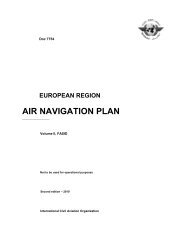7754 Vol 1 Flyleaf - ICAO Public Maps
7754 Vol 1 Flyleaf - ICAO Public Maps
7754 Vol 1 Flyleaf - ICAO Public Maps
You also want an ePaper? Increase the reach of your titles
YUMPU automatically turns print PDFs into web optimized ePapers that Google loves.
I-8 EUR BASIC ANP<br />
occurred, or is expected to occur. When justified by the<br />
number of aircraft suitably equipped, data links should be<br />
recommended for these functions, as well as for certain<br />
clearance deliveries.<br />
5.2.3 Aerodromes having a significant volume of<br />
international general aviation traffic should be served by<br />
stations of the AMS, and such stations should operate on<br />
frequencies within the bands normally used by aircraft<br />
constituting this traffic.<br />
5.2.4 Selective calling (SELCAL) devices should be<br />
employed, wherever possible and necessary, at<br />
aeronautical stations.<br />
5.2.5 An air-to-air VHF communication channel<br />
(INTERPILOT) on the frequency 123.450 MHz should be<br />
used over remote and oceanic areas, provided users are<br />
out of range of VHF ground stations, to enable pilots to<br />
exchange the necessary operational information.<br />
5.3 Frequency assignment plans<br />
5.3.1 Frequency assignment planning should be done<br />
in accordance with the method applicable to the region<br />
and using the relevant <strong>ICAO</strong> regional office frequency<br />
lists.<br />
6. NAVIGATION<br />
6.1 General<br />
6.1.1 The planning of navigation aids should be based<br />
on a system basis, recognizing that the requirements for<br />
both long range and short range navigation may be met by<br />
different navigation systems having area navigation<br />
capability, including the global navigation satellite system<br />
(GNSS), and it may be practicable to establish ATS routes<br />
not provided with ground station-referenced aids for<br />
suitably-equipped aircraft. For routes or areas which<br />
require that aircraft achieve an acceptable level of<br />
navigation accuracy, the requirement should be specified<br />
e.g. in the form of a required navigation performance<br />
(RNP) type to support a selected horizontal separation<br />
minimum, or a minimum aircraft system performance<br />
specification (MASPS) to support a selected vertical<br />
separation minimum. The navigation systems should meet<br />
the needs of all aircraft using it and form an adequate<br />
basis for the provision of air traffic services.<br />
6.1.2 Where aircraft are using different systems for<br />
navigation and position determination within the same<br />
controlled airspace, the facilities involved should, in so far<br />
as practicable, be located and oriented to enable a fully<br />
integrated air traffic control structure to be established.<br />
6.1.3 Planning should take into account the need of<br />
civil aircraft for sufficiently accurate navigation guidance<br />
to remain clear of restricted, prohibited and danger areas<br />
as required.<br />
6.2 International commercial air transport<br />
operations<br />
6.2.1 En-route aids<br />
6.2.1.1 The en-route aids to be recommended should<br />
provide navigation assistance to permit en-route<br />
navigation on the agreed air traffic services route network<br />
with the accuracy required.<br />
6.2.1.2 It is expected that GNSS will ultimately meet all<br />
requirements for en-route navigation. Planning for other<br />
en-route aids should take due account of the need for a<br />
gradual transition towards the use of GNSS in lieu of<br />
en-route ground-based navigation aids. Pending<br />
implementation of GNSS, VHF omnidirectional radio<br />
range (VOR) supplemented as necessary by distance<br />
measuring equipment (DME) should be installed as the<br />
primary aid for this purpose.<br />
6.2.1.3 Where VOR is used, supplemented as necessary<br />
by DME, a total navigation error value for VOR of ±5<br />
planning purposes. However, the specific value of VOR<br />
radial signal error for individual facilities/radials should<br />
be obtained by flight checking, and if these values are<br />
taken in respect of the routes concerned.<br />
6.2.1.4 Long-distance radio navigation aids continue to<br />
be provided where required.<br />
6.2.2 Terminal area aids<br />
6.2.2.1 The terminal area aids should permit navigation<br />
for arrival and approach, holding and departure to be<br />
carried out with the accuracy required.<br />
6.2.2.2 It is expected that GNSS will ultimately meet all<br />
requirements for terminal navigation. Planning for other<br />
terminal aids should take due account of the need for a<br />
gradual transition towards the use of GNSS in lieu of<br />
terminal area ground-based navigation aids. Introduction<br />
of GNSS-based navigation services, such as Basic GNSS<br />
and satellite-based augmentation system (SBAS), should<br />
be considered as initial transition steps.<br />
6.2.2.3 Where VOR is used as the primary aid, it should<br />
be so located as to permit the most efficient approach and<br />
air traffic control procedures and to give the pilot














